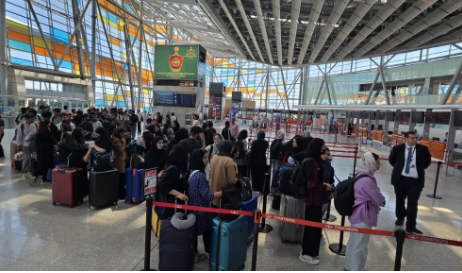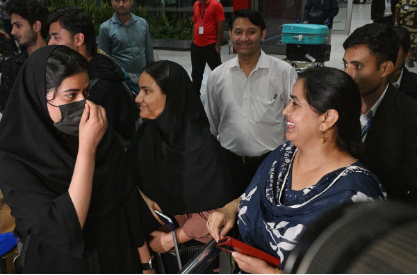
In a deeply emotional plea, a couple from Bengaluru is appealing to the Indian government for the immediate evacuation of their daughter, who is currently stranded in Iran amid increasing civil unrest and political instability. The desperate parents are living through days of anxiety and sleepless nights, unable to do anything but hope for their daughter’s safe return. Their daughter, a young medical student, left India with dreams of building a better future, but is now stuck in a volatile situation that threatens her safety and well-being. This family’s story is just one among many that highlight the human cost of geopolitical crises and the urgent need for swift humanitarian response.
A Promising Journey Turned Uncertain
The 28-year-old woman had moved to Tehran, Iran’s capital, in 2022 to pursue her postgraduate medical education. Coming from an academically inclined family, she had always aspired to become a doctor. After thorough research, she chose a reputed medical university in Tehran and moved with optimism and confidence. For the first year, everything went as planned. She adjusted to the new culture, made friends, and focused on her studies. However, by early 2024, signs of trouble began to emerge.
The once-bustling streets of Tehran started witnessing frequent protests, many of which turned violent. Rising tensions between the public and the government over economic issues, civil liberties, and foreign relations led to widespread demonstrations. What began as occasional incidents soon evolved into daily unrest, with internet blackouts, food shortages, and restrictions on movement.
A Mother’s Nightmare
The girl’s mother, overwhelmed with emotion, called the situation the “most terrible state for any mother.” Speaking to the media with tear-filled eyes, she said, “We talk every day, and all she does is cry. She’s scared, hungry, and alone. She pleads with us to bring her back home. But what can we do from here?” Her mother described how her daughter was unable to step out of her rented apartment due to security risks. “She hasn’t seen daylight in weeks. She eats whatever is left in her kitchen. It’s not just physical safety—she’s mentally breaking down.”
Her father added, “As a parent, it’s a helpless feeling. We want to be there for her, but all we can do is make calls and send emails.”
Plea to the Indian Government
The family has written multiple letters and emails to the Ministry of External Affairs (MEA) and also reached out to the Indian Embassy in Tehran. They submitted an official request for emergency evacuation, not just for their daughter, but for all Indian nationals who are in similar danger. So far, they have received a few acknowledgments, but no concrete plan has been communicated to them.
“We still believe in the system. We believe in the government,” the father said. “But time is running out. Every day feels like we’re rolling dice with our daughter’s life.”
To gain traction, the family has also contacted local politicians and Members of Parliament, urging them to push the matter at the national level. They even started a petition online to gather public support, hoping that media pressure will accelerate government action.
The Situation in Iran: A Growing Crisis
Iran is currently going through one of the most unstable periods in its recent history. Protests that started over civil rights violations and economic mismanagement have spread across the country. University students, activists, and even professionals have joined the protests, demanding reform and freedom.
The government’s reaction has been severe. Internet shutdowns, arrests, curfews, and strict surveillance have made everyday life difficult, especially for foreigners. Indian students, including the girl from Bengaluru, find themselves stuck in this chaos, unable to travel or access essential services.
Supermarkets in Tehran are reportedly running out of basic supplies. Banks are only partially functioning. With limited cash and digital access blocked, many foreign students are now borrowing from each other or relying on help from local Indian associations. But even those associations are facing resource constraints as the crisis deepens.
The Mental Health Toll on Students
Beyond physical safety, the situation is causing deep emotional distress to Indian students. The Bengaluru student recently broke down during a video call with her family. “She’s not eating, not sleeping. She’s suffering from panic attacks,” her mother said. “We are worried that even if she comes back, she may not be the same mentally.”
Doctors have repeatedly emphasized the importance of mental health support during crises. But with no access to therapists and declining morale, students are becoming more vulnerable by the day. The stress is not just on them but also on their families, who feel helpless thousands of kilometers away.
India’s Official Stand and Global Comparisons
The Ministry of External Affairs recently stated that it is in “continuous contact with the Indian embassy in Tehran” and that the safety of Indian nationals remains a top priority. However, unlike countries such as the United States and the United Kingdom, which have already issued travel advisories and are actively evacuating their citizens, India has yet to roll out a concrete evacuation plan.
This delay is increasing anxiety among Indian families across the country. Parents of students in Iran from Kerala, Tamil Nadu, Maharashtra, and Karnataka have joined social media campaigns using hashtags like #EvacuateIndiansFromIran and #HelpOurChildren. These hashtags are now trending on Twitter and Instagram, with thousands urging the government to act quickly.
Indian Community in Iran Supports Each Other
Despite the challenges, the Indian diaspora in Iran is showing immense solidarity. Local Indian associations are doing their best to distribute groceries, water, and medicines to Indian students. They’ve created WhatsApp groups and shared emergency contact numbers in case of police detentions or medical emergencies. However, these efforts can only go so far.
An Indian student studying pharmacy in Iran said, “We are trying to help each other. But we don’t know how long we can survive like this. Our families are worried. We are worried. We just want to go home.”
Hope and Heartbreak in Equal Measure
Back in Bengaluru, the girl’s parents are clinging to hope. Every phone call, every government announcement, every email reply feels like a potential turning point. Her mother keeps her daughter’s room ready. “I clean her bed every day. I want her to feel at home the moment she walks in,” she says. But with no confirmed date or plan, they are caught between hope and heartbreak.
Their daughter’s last video call ended with a trembling voice: “I just want to be with you, Amma.” That one sentence, the mother says, keeps ringing in her ears.
The Larger Picture: A Wake-Up Call
This heartbreaking situation serves as a wake-up call for better systems and protocols to evacuate Indian citizens from conflict zones. While the government has taken action in past situations like Ukraine and Sudan, timely intervention is key. Waiting too long can cost lives and scar families permanently.
The world today is increasingly volatile. Countries can descend into chaos within days. For India, a country with one of the largest diaspora populations, proactive international response mechanisms are no longer optional—they are essential.
The emotional and physical turmoil faced by the Bengaluru girl and her family is just one example of how international conflicts deeply affect ordinary lives. As the situation in Iran continues to deteriorate, it is critical that the Indian government steps in with a clear evacuation plan. Every Indian citizen, whether at home or abroad, deserves to feel safe.
The Ministry of External Affairs, along with Indian embassies, must act swiftly, compassionately, and decisively. These are not just names in a file—they are daughters, sons, and loved ones, desperately hoping to return to safety.
For the Bengaluru parents, every passing day without action is a fresh wound. For the rest of the nation, it is a reminder of how fragile safety can be—and how powerful timely help is.































